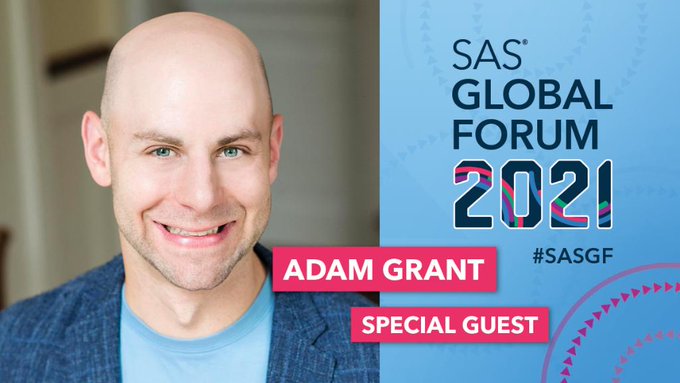Organizational psychologist Adam Grant studies how we lead, work and live and his pioneering research has inspired people to question their assumptions about motivation, generosity and creativity. His unique and counterintuitive ideas are backed by data-driven science and case studies (he loves data just as much as I do!).
Adam's books have sold millions of copies and his Ted Talks have 25 million views. I got to speak with him at SAS Global Forum this week about imposter syndrome, confident humility -- and the power of knowing what you don’t know.
Confident humility and imposter syndrome
Jenn Chase:
I’ve been inspired by your books, from Give-and-Take to Originals, and now your latest, Think Again: The Power of Knowing What You Don’t Know. It resonated with me for two reasons: One, it strikes me as a very timely account of where we are as a society, and two, it reads like a handbook for how we at SAS think about making the world a better place.
Let’s start today’s discussion with the premise of Think Again. Can you summarize it for us?
Adam Grant:
The basic premise is that many leaders fail to recognize that the faster you can realize you're wrong, the faster you can be right. That takes what I call confident humility.
That means thinking more like scientists and less like preachers, prosecutors or politicians. It means being humble about our convictions and beliefs, curious about the alternatives, and open to discovery and experimentation.

Chase:
Yes! I loved how you brought those two words “confidence” and “humility” together in Think Again. It literally made me think again. You talk about confident humility being the sweet spot between ‘armchair quarterback’ and ‘imposter syndrome.’ As a woman, I think I’ve felt ‘imposter syndrome,’ and a lot of women might be in this situation. How can we turn it into a strength
Grant:
Imposter syndrome … it sounds like a chronic disease, and it can be if people think that they’re frauds and don’t belong. That can undermine confidence, performance and motivation. It’s more common to have moments of self doubt, like: “Am I qualified for this role?”; “Am I up to the challenge?”
Basima Tewfik’s research suggests that there are surprising benefits to doubting whether you’re as good as others think you are:
- Medical professionals listen to their patients more carefully when they have more frequent impostor thoughts.
- Investment professional made better decisions on average when they had imposter thoughts.
- Impostor thoughts can motivate you to work harder and smarter.
- They can remind you that you don’t know everything and need to learn from others.
- They might cause you to rethink the way that everybody else has always done things.
It’s easy for me, as a white man, to find motivation in those moments because I live in a world that generally assumes that I’m competent. If you’re a woman or a person of color, people are more likely to question your confidence and you have to prove it, day in, day out. It’s a harder situation, but the basic premise holds: When you have those imposter thoughts, see them as an opportunity to be a better learner and use it to propel yourself forward, instead of holding yourself back.
Building a challenge network
Chase:
I’ve been inspired by your concept of a ‘challenge network,’ people who are thoughtful critics and point out your blind spots. For me, I was looking for people who had diversity of thought and experience. What qualities should people look for when they build a challenge network?
Grant:
One of the first things to look for is someone who understands what you’re trying to contribute to the world. Another thing to think about when you’re considering someone is, do you respect them, even if you disagree with them? Do I respect the integrity of their thought process? Do they ask important questions, and are they disciplined, and even scientific, about getting the answers, regardless of where they land. Will they help me think again?
Chase:
Tell us more about that. What are some of the practical steps you take in order to relearn and rethink?
Grant:
One thing I do after every event is go to the first people I see and ask, “What is one thing I can do better or one thing I should rethink?” A lot of times, people won’t tell me; they say they were listening and absorbing and not thinking critically about it. And I find that disappointing because they deprive me of a learning opportunity.
So, I dig a little deeper and ask them, “On a scale of 0 to 10, how was it? And how can I get closer to a 10?” That signals to them that I’m looking to them as a coach who can teach me something. It lets them know, you won’t crush my ego, but you will help me learn how to get better. Asking the questions that way opens the floodgates, and I highly recommend it.
Productive conflict and psychological safety at work
Chase:
We talk about psychological safety at work and creating an environment where disagreements and conflicts can happen in a productive way. When you have productive conflict, you have a more productive team. How can we create that psychological safety in a work environment?
Grant:
One of the mistakes I see is leaders saying, ‘Don’t bring me problems, bring me solutions.’ I get why leaders say this. You don’t want people to whine and complain, but I believe it’s a dangerous philosophy because if people can only speak up when they have a solution, leaders will never learn about the biggest problems.
The foundation of psychological safety is making it possible for people to raise problems, even if they don’t know how to fix them yet. It empowers the ‘canaries in the coal mine,’ who may not have the expertise or resources to fix the problem, to at least raise the issues so we can begin to tackle them. So, making it easy for people to speak up about problems is the best solution for psychological safety.
Turning languish into flourish
Chase:
Let’s talk about mental fitness. We’re living in a time where our entire lives have been disrupted. You recently wrote a New York Times article about languishing, which put a word to a term that many of us are feeling as we go through all these phases of the pandemic. Can you give us advice for turning the languish into flourish?
Grant:
At first, when I heard people say they weren’t looking that forward to getting out of the pandemic, I thought they were mildly depressed. But what I realized was that they weren’t feeling sad – they were feeling hopeless. And then I thought maybe they were burned out … but the more I thought about it and reflected on times when I felt that way, I realized that there is a term for it in psychology. It’s called languishing. It’s that feeling of emptiness and stagnation where it seems like you’re joyless and aimless and looking at life in grayscale as opposed to vivid color.
It’s between depression and flourishing, and it’s not good mental health. It undermines focus and increases the likelihood that people take time off of work. It could also bleed into depression. We know more about this condition than how to solve it, but if languishing is stagnation, the antidote seems to be progress.
Look for forward movement. Celebrate small wins -- even if you didn’t achieve your goal, you moved toward it. That helps build a sense of momentum. I also advise blocking out and clearing interruptions. We need windows of time where we can be totally absorbed in what you’re doing. I think we need protected windows to help people do that. It might be “No Meeting Wednesdays,” or no interruptions on several days before noon. Set your boundaries so you can move from languishing to flourishing.
Learn more
Watch SAS Global Forum’s Opening Session to see my full conversation with Adam Grant. You can also check out my LinkedIn post featuring Adam Grant’s talk on “What frogs in hot water can teach us about thinking again.”


